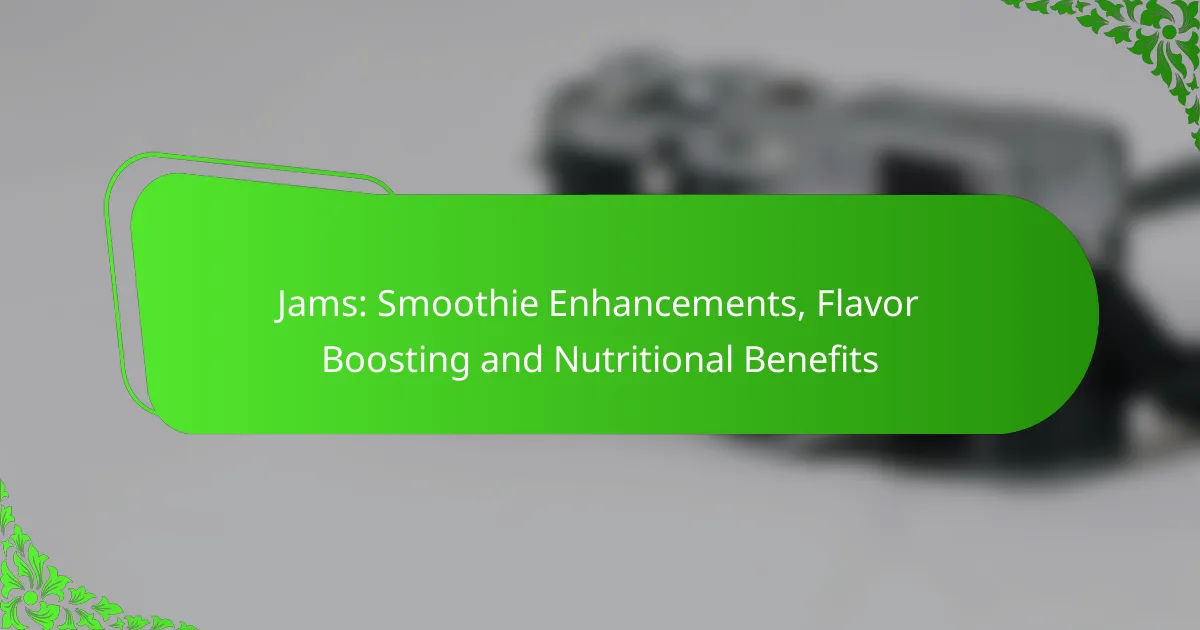Exploring the art of jam-making involves mastering glazing techniques, roasting methods, and flavor boosts that can transform simple preserves into gourmet delights. By incorporating glazes made from fruits, herbs, and spices, you can add depth and complexity to your jams. Roasting fruits enhances their natural sweetness and introduces caramelized notes, while thoughtful flavor boosts from spices and citrus can elevate the overall taste experience. Together, these methods create a symphony of flavors that will delight any palate.

What glazing techniques enhance jam flavor?
Glazing techniques can significantly elevate the flavor of jams by adding depth and complexity. These methods involve applying various glazes made from fruits, herbs, spices, citrus, or alcohol, each contributing unique taste profiles and enhancing the overall experience.
Fruit-based glazes
Fruit-based glazes are made by reducing fruit juices or purees until they thicken and intensify in flavor. Common choices include apple, berry, or citrus juices, which can complement the primary fruit in the jam. For example, a raspberry jam can be enhanced with a glaze made from reduced raspberry juice mixed with a touch of sugar.
To create a fruit glaze, simmer the juice over low heat until it reduces by half, stirring occasionally. This process typically takes around 10 to 20 minutes. Ensure that the glaze cools slightly before applying it to avoid melting the jam.
Herb-infused glazes
Herb-infused glazes incorporate fresh or dried herbs to add a savory note to jams. Popular herbs include basil, mint, and rosemary, which can create a delightful contrast to sweet fruit flavors. For instance, a mint glaze can enhance a strawberry jam, providing a refreshing twist.
To make an herb-infused glaze, steep the herbs in hot water or vinegar for about 10 minutes, then strain and reduce the liquid until it thickens. This method allows the herbal flavors to meld beautifully with the jam.
Spiced glazes
Spiced glazes introduce warmth and complexity through the use of spices like cinnamon, ginger, or cardamom. These spices can enhance the natural flavors of the fruit while adding aromatic qualities. A spiced glaze can work particularly well with apple or pear jams.
To prepare a spiced glaze, combine your chosen spices with sugar and water, then simmer until the mixture thickens. This typically takes around 15 minutes. Be cautious not to overpower the jam with spices; a little goes a long way.
Citrus glazes
Citrus glazes utilize the brightness of citrus fruits like lemon, lime, or orange to add acidity and balance to jams. They can help cut through the sweetness, making the jam more versatile. For example, a lemon glaze can enhance blueberry jam, providing a zesty contrast.
To create a citrus glaze, combine citrus juice with sugar and simmer until it thickens, usually taking about 10 minutes. Adjust the sweetness to taste, ensuring it complements rather than overwhelms the jam.
Alcohol-based glazes
Alcohol-based glazes can add depth and richness to jams, with options like rum, whiskey, or wine. These glazes can enhance the flavor profile and provide a sophisticated touch. A rum glaze, for instance, can elevate a tropical fruit jam, adding warmth and complexity.
To make an alcohol-based glaze, combine the alcohol with sugar and simmer until it reduces and thickens, which typically takes around 15 minutes. Be mindful of the alcohol content; ensure it is cooked off sufficiently to avoid overpowering the jam’s flavor.

How do roasting methods affect jam making?
Roasting methods significantly influence the flavor and texture of jams by enhancing the natural sugars in fruits and introducing complex, caramelized notes. Each technique offers distinct characteristics that can elevate the final product, making it essential to choose the right method for your desired outcome.
Oven roasting
Oven roasting involves placing fruits on a baking sheet and cooking them in a preheated oven, typically at temperatures ranging from 350°F to 400°F (175°C to 200°C). This method allows for even cooking and caramelization, which intensifies the fruit’s sweetness and adds depth to the jam. Aim for about 20 to 30 minutes of roasting, turning the fruits halfway through for uniform results.
When using oven roasting, consider the type of fruit. Denser fruits like apples and pears hold up well, while softer fruits may break down too much. A light sprinkle of sugar before roasting can enhance caramelization.
Stovetop roasting
Stovetop roasting involves cooking fruits in a skillet over medium heat, allowing for quick caramelization and flavor development. This method is particularly effective for smaller batches and can take anywhere from 10 to 15 minutes. Stir frequently to prevent sticking and ensure even cooking.
For stovetop roasting, use a heavy-bottomed pan to distribute heat evenly. Adding a splash of lemon juice can help balance the sweetness and enhance the overall flavor profile of the jam.
Grilling fruits
Grilling fruits adds a smoky flavor and attractive grill marks, making it an appealing option for jam making. Use a medium-high heat setting and grill fruits like peaches, pineapples, or strawberries for about 5 to 10 minutes, turning occasionally. The sugars in the fruit caramelize beautifully, enhancing sweetness.
To maximize flavor, brush the fruits lightly with oil or a sweet marinade before grilling. This method works well for fruits that can hold their shape, and the resulting jam will have a unique, charred flavor that can elevate your spreads.
Smoking fruits
Smoking fruits introduces a rich, complex flavor that can transform your jam. This method requires a smoker or a stovetop smoking device, where fruits are exposed to wood smoke for a short period, usually around 30 minutes. Choose fruits that can withstand the process, such as apples or pears.
When smoking, consider the type of wood used, as different varieties impart distinct flavors. After smoking, allow the fruits to cool before incorporating them into your jam recipe. This technique can create a unique product that stands out in flavor and aroma.

What flavor boosts can be added to jams?
Flavor boosts can enhance the taste of jams, making them more complex and enjoyable. Common additions include spices, herbs, and citrus, which can elevate the overall profile of the jam.
Vanilla bean
Adding vanilla bean to jams introduces a rich, aromatic sweetness that complements many fruits. Use half a bean per batch for a subtle flavor or a whole bean for a more pronounced taste. Scrape the seeds into the jam while cooking to ensure even distribution.
Consider pairing vanilla with fruits like strawberries or peaches, as the warm notes of vanilla enhance their natural sweetness. Avoid using vanilla extract, as it can introduce alcohol and alter the jam’s consistency.
Chili pepper
Chili pepper can add a spicy kick to jams, creating a unique sweet-and-spicy flavor profile. Use fresh or dried chili peppers, adjusting the amount based on your heat preference. Start with a small amount and taste as you go to avoid overpowering the jam.
This flavor boost works well with fruits like mango or tomato, where the heat can balance the sweetness. Be cautious with the type of chili used; milder varieties like jalapeños can provide warmth without overwhelming heat.
Ginger root
Ginger root adds a zesty, warming flavor that pairs beautifully with many fruits. Fresh ginger is best for a bright, spicy note, while ground ginger can provide a more subtle warmth. Grate fresh ginger and add it during the cooking process for optimal flavor infusion.
Consider using ginger in jams made from pears or apples, as the spice complements their natural sweetness. Start with a small amount, as ginger can quickly dominate the flavor profile if overused.
Lemon zest
Lemon zest brings a bright, citrusy freshness to jams, enhancing the overall flavor and adding a touch of acidity. Use the zest of one lemon for every few cups of fruit to achieve a balanced taste. Be sure to avoid the bitter white pith when zesting.
This addition works particularly well with berries, as the acidity can help to brighten their flavors. Lemon zest can also help preserve the color of lighter jams, making them visually appealing.

What are the best fruit combinations for jams?
The best fruit combinations for jams enhance flavor and texture while balancing sweetness and acidity. Popular pairings often include berries, citrus, and stone fruits, each offering unique characteristics that can elevate your jam-making experience.
Berry blends
Berry blends are a favorite for jam-making due to their natural sweetness and vibrant colors. Common combinations include strawberries with blueberries or raspberries, which create a rich flavor profile. When using berries, consider their sugar content; you may need to adjust added sugar accordingly.
For a successful berry jam, aim for a mix of sweet and tart varieties to achieve depth. A typical ratio could be two parts sweet berries to one part tart berries, ensuring a balanced final product.
Citrus mixes
Citrus mixes bring a bright, zesty flavor to jams. Popular combinations include oranges with lemons or limes, which provide a refreshing tang. When making citrus jams, be mindful of the pith, as it can add bitterness if not removed properly.
To enhance the citrus flavor, consider adding zest along with the juice. A good starting point is to use the zest of one medium-sized fruit for every two cups of juice, which helps intensify the citrus notes in your jam.
Stone fruit combinations
Stone fruits like peaches, plums, and cherries are excellent for creating rich, flavorful jams. Pairing peaches with cherries or plums can yield a delightful blend that balances sweetness and tartness. When selecting stone fruits, choose ripe ones for the best flavor and texture.
For optimal results, consider using a mix of soft and firm stone fruits. This combination can help maintain a pleasant texture in the final jam. A typical ratio might be three parts soft fruit to one part firm fruit, ensuring a spreadable consistency.










